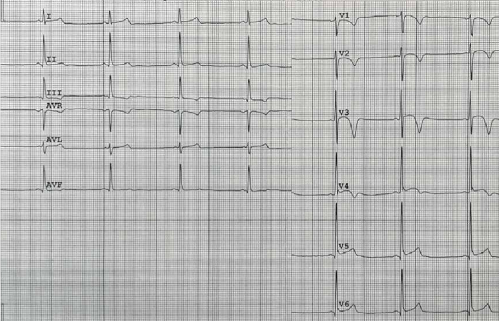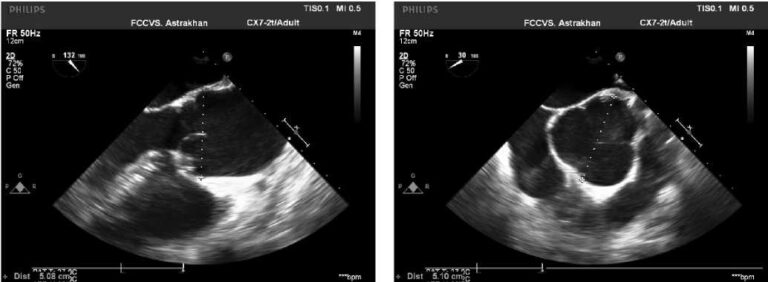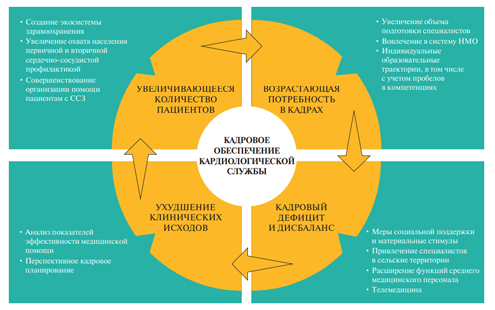Genetic and epigenetic factors regulating the expression and function of the vitamin D receptor in patients with coronary artery disease
Coronary artery disease (CAD) is the most common cardiovascular disease (CVD) and is the leading cause of disability and mortality worldwide, including working-age people [1][2]. It is a complex, multifactorial and polygenic disease, the pathogenesis of which is based on the interaction between genetic predisposition and environmental factors [2].
Recent studies have shown that traditional risk factors (RF), including dietary errors, obesity, diabetes, hypertension, dyslipidemia, smoking and alcohol abuse, can predict the risk of cardiovascular events and complications only in 50% of cases. [3]. Therefore, it is extremely important to study new RFs of CAD, especially genetic and epigenetic ones [4].
A number of authors have found that genetic screening will allow 12% of patients to requalify the CVD risk from moderate to high, therefore, a multilocus genetic risk score for diseases and its complecations has been developed [5].
To analyze the hereditary predisposition to CVD, characteristic of polygenic diseases, in addition to genetic factors affecting the CAD risk, an important role is played by the assessment of atherogenesisrelated epigenetic factors, primarily the microRNAs, which are small noncoding RNAs that regulate transcriptional or posttranscriptional expression [6].
Recent studies have shown that vitamin D is not only the most important regulator of calcium and phosphorus metabolism, but also plays an important role in vascular immune inflammation, pathogenesis of atherosclerosis [7], and carcinogenesis [8].
Both epidemiological and laboratory studies have shown a positive effect of vitamin D on cardiovascular function [7, 9].
Vitamin D receptor
The vitamin D receptor (VDR) is a member of the steroid hormone receptor. It is necessary to implement the functions of related ligand, vitamin D, being an important regulator of the pathogenetic pathway of vitamin D, since VDR is involved in the conversion of serum 25-hydroxyvitamin D to active 1,25-dihydroxyvitamin D [10].
The VDR consists of 427 amino acids and has 2 main functionally significant domains: the N-terminal domain, through which the nuclear receptor is attached to DNA, and the C-terminal domain, which is required for ligand binding. It is known that VDR belongs to nuclear receptor superfamily — transcription factors that regulate the expression of many genes. After binding to ligands, nuclear receptors are activated and bind in the cell nucleus with DNA regions localized in the promoter of target genes [11].
VDR in the human body is found in many organs and tissues: vascular smooth muscle cells, endothelial cells, cells of the immune system, kidneys, intestines, bones, parathyroid glands. The ubiquitous distribution of VDR reflects its pleiotropic biological activity [10].
VDR regulates the expression of some genes involved in atherogenesis. The presence of VDR in vascular smooth muscle and endothelial cells, combined with the ability of vascular tissues to activate vitamin D, indicates the role that vitamin D may play in normal vascular physiology and its importance in CAD prevention. This is supported by the Valcheva P, et al. Study with laboratory mice: vascular smooth muscle cells of VDR knockout mice more actively produced cathepsin D (enzyme with reninlike activity) and angiotensin II [12].
In a laboratory study by Yao T, et al., the protective role of vitamin D in modeled myocardial infarction (MI) was shown: VDR stimulation with related ligands improved the cardiac contractile function and decreased the MI area due to the improvement of mitochondrial function, reduction of endoplasmic reticulum damage and inhibition of cardiomyocyte apoptosis [13].
It was found that VDR affects the plaque stabilization by suppressing the neoangiogenesis, which predisposes to rupture of unstable atherosclerotic plaques. VDR, binding to the ligand, suppresses angiogenesis by inhibiting the vascular endothelial growth factor production. In addition, vitamin D through the VDR in endothelial cell cultures reduces the P-selectin (CD62P) expression [14].
Vitamin D has been shown to reduce the expression of endothelin, tissue factor, and epidermal growth factor by smooth muscle cells with VDR on their surface. This prevents the migration of smooth muscle cells and slows down the atherosclerotic plaque growth [15].
VDR gene polymorphism
The recent studies established that a single nucleotide polymorphism of the VDR gene is a potential RF for CAD associated with low vitamin D levels, but the exact mechanisms underlying the effect of polymorphic VDR gene variants on CAD pathogenesis are not fully understood [16, 17].
The VDR gene was discovered by Baker AR, et al. in 1988 [18]. This gene is located on chromosome 12 (12q12-14) and includes at least 5 promoter regions generating several tissue-specific transcriptions, 8 exons encoding a protein, and 6 untranslated exons with alternative splicing [19]. The VDR gene is 100 kb in size.
Currently, more than 470 types of VDR gene single nucleotide polymorphism have been found, while among them 4 polymorphisms (FokI (rs10735810), BsmI (rs1544410), ApaI (rs7975232) and TaqI (rs731236)) have been thoroughly studied for their effect on various physiological and pathological phenotypes, such as cancer, diabetes, Parkinson’s disease, myocardial infarction and CAD [19-21].
VDR gene polymorphic variants can potentially affect VDR expression and VDR mRNA stability [7].
VDR FokI polymorphism is localized in the second exon of the fifth codon [22] and is characterized by cytosine-to-thymine substitution in the start-codon ATG? ACG. Among the many different types of VDR gene polymorphism, this polymorphism is the only one not associated with other VDR gene polymorphisms, as well as the only polymorphism that leads to two different VDR protein products [23].
The minor f (T) allele of this gene encodes a fulllength protein of 427 amino acids, with translation initiation occurring at the first ATG site, while in carriers of the F (C) allele, translation begins at the second ATG start codon in exon 2. Thus, the F (C) allele encodes a protein shortened by 3 amino acids, which is 1,7 times more efficient than the long one for transactivation of target genes due to more active transcription [7]. Consequently, the VDR gene FF genotype play a significant role in CAD development indirectly through vitamin D deficiency [7].
These data were also confirmed by the analysis of 20 fibroblast cell lines, where it was revealed that the shortened protein encoded by the F allele interacts more actively with the transcription factor due to special genetic effects in the promoter region of targeted genes. Thus, some promoter regions of targeted genes for VDR are sensitive to these genotypedependent differences in activity [8].
The results of studies on relationship between VDR FokI polymorphism and CAD are contradictory. He l, Wang M [16] showed an association between VDR FokI polymorphism and CAD in the Chinese population, but Pan XM, et al. [22] do not reveal such association. This can be explained by the small sample size of subjects. The study by Shanker J, et al. with the Indian population also did not reveal an association between VDR FokI polymorphism and CAD [23]. Perhaps this is due to the peculiarities of VDR gene polymorphism distribution in different populations.
Results from studies by Hossein-Nezhad A, et al. showed that vitamin D deficiency is less common in patients with VDR gene FF genotype, which implies a protective role of the F allele in CAD development [9].
These findings are supported by a 2016 metaanalysis by Lu S, et al. The authors showed that carriers of VDR gene FF genotype had 19% reduced risk of CAD [7].
TaqI, ApaI and BsmI polymorphisms of the VDR gene are interrelated and localized between the eighth and ninth exons in the 3’ terminal region of the VDR gene, containing microsatellite sequences of different lengths — short (S) and long (L), which can affect the translational activity and stability of VDR mRNA [16].
There are 3 main haplotypes of the VDR gene with different activities [16]:
1) baT haplotype — 48% of the population;
2) BAt haplotype — 40% of the population;
3) bAt haplotype — occurs much less often.
There were no differences between haplotypes with regard to regulation of messenger RNA stability. Only a tendency for the BAt haplotype to express higher levels of messenger RNA in monocytes was revealed as compared to baT haplotype carriers [16].
The prospective DIABHYCAR study found that the bAt haplotype of the VDR gene (AAC) was associated with an increased CAD risk in type 2 diabetes patients. This effect was independent of the influence of other known CVD RFs [24].
BsmI and ApaI polymorphisms of the VDR gene control protein expression by regulating the messenger RNA stability and are localized in the 8th intron of the 3’ regulatory region. This is most common for steroid hormone receptors, which contain large regulatory regions. Patients carrying the BB and Bb genotypes of the VDR gene had a higher hypertension prevalence. An association of the bb/Aa genotype with ischemic stroke was noted [25].
In the Arab population, El-Barbary AM, et al. found a relationship between the bb genotype of the VDR gene and atherosclerotic vascular lesions [26], while Al-Ghamdi AS, et al. [27] reported no association of this genotype with CAD in Saudi Arabia. The small number of patients examined may partly explain the conflicting results.
A stratified analysis of VDR BsmI polymorphism by ethnicity revealed an increased risk of CAD in the European population among b (A) allele carriers by 23% compared with B (G) allele carriers. Moreover, bb (AA) and Bb (AG) carriers had 56% and 20% higher risk of CAD than BB (GG) carriers [28].
In the Asian population, there was no association between the VDR BsmI polymorphism and CAD risk. This may be due to the fact that the alleles of this polymorphism are located between the 8th intron and the 9th exon of the VDR gene, which has an unbalanced linkage in different ethnic groups [28].
VDR ApaI polymorphism affects the stability of messenger RNA [29]. Since VDR plays an important role in vitamin D signaling, it can be assumed that the VDR ApaI polymorphism may also influence the CAD risk, either by altering the sensitivity of the receptor to ligands, or by gene-gene interactions or environmental effects on genes.
Carriage of VDR gene Aa (CA) genotype was associated with a decrease in CAD risk in type 2 diabetes patients, and it is likely that this genotype may be associated with a low risk of CAD, but larger studies are required to confirm this [24].
VDR TaqI polymorphism was described in 1994 [28]. It is due to cytosine-to-thymine replacement at codon 352. This leads to the replacement of the AUU (isoleucine) codon with AUG (methionine) [10]. According to the meta-analysis, the tt genotype is associated with an increased risk of CAD in the range from 14% to 27% in various studies [30].
The results of studies on relationship between the VDR gene polymorphism and CAD are contradictory. For example, the meta-analysis conducted by Alizadeh S, et al. did not show a relationship between FokI, BsmI, ApaI and TaqI polymorphisms of the VDR gene with CAD risk [30], which may be associated with the different prevalence of the above genotypes in different ethnic and racial groups. For example, the prevalence of VDR gene f allele (FokI polymorphism) was less common among Africans than among Asians, while the B allele BsmI polymorphism) was less common in Asians than in Europeans and Africans [16]. In the literature, there are practically no studies devoted to the occurrence of FokI, BsmI, ApaI and TaqI polymorphisms of the VDR gene and their relationship with CAD risk and its clinical course features in the Northwestern region of Russia.
Prabhakar P, et al. did not establish a relationship between the carriage of different ApaI and TaqI genotypes of the VDR gene polymorphism and ischemic stroke. In examined carriers of VDR gene ff genotype, the risk of ischemic stroke increased by 2,97 times, while in carriers of the Ff genotype — by 1,52 times. Homozygous carriage of VDR gene f allele was associated with increased total cholesterol levels. Carriage of VDR gene bb genotype increased the risk of ischemic stroke by 1,76 times. In addition, the authors found that persons with vitamin D deficiency (<20 mg/ml) also have an increased risk of ischemic stroke [31].
TaqI, ApaI and BsmI polymorphisms of the VDR gene can affect the expression of VDR mRNA and contribute to a decrease in vitamin D levels in CAD patients. Although genetic factors contribute significantly to the variability of circulating vitamin D levels, heritability is estimated to be 30-40% [28]. An imbalance was observed only in these three polymorphisms, and they were in the same haploid domain with a 3’ regulatory domain. The haploid domain includes 4-9 exons and a 3’ regulatory domain, which is associated with gene expression regulation, especially with the regulation of mRNA stability.
Apparently, carriers of unfavorable prognostic genotypes of the VDR gene also have a reduced ability to inhibit the NF-kB signaling pathway. NF-kB, in turn, prolongs the activation of macrophages and increases the expression of adhesive molecules on endothelial cells, thereby supporting the development and progression of atherosclerotic vascular lesions [32].
Epigenetic mechanisms of vitamin D receptor regulation
The recent studies have shown that 80% of genome function consists in the epigenetic regulation of the expression of genes encoding proteins. MicroRNAs are small noncoding RNAs that are the most important regulators of transcriptional and posttranscriptional gene expression. MicroRNAs are single-stranded regulatory molecules for 30% of all genes. They have a specific hairpin-like structure, ranging in length from 19 to 24 nucleotides, which are formed from longer RNA precursors [6]. MicroRNAs suppress the posttranscription expression of genes encoding proteins due to incomplete hybridization with the 3’ regulatory untranslated region of mRNA, which has complementary sites.
MicroRNAs are effective posttranscriptional regulators of gene expression [6]. They drive complex posttranscriptional regular networks required to regulate gene expression. Thus, microRNAs are required for the fine-grained transcriptional regulation of gene expression, but they can also play different roles in the proliferation, differentiation, and function of certain cell types.
Currently, 1000 microRNAs have been identified in the human body, 50 of which are probably associated CVD risk [29].
MicroRNAs, like cytokines, form an interconnected regulatory system that controls apoptosis, proliferation, and tissue differentiation. MicroRNAs play an important role in the normal physiology, facilitating the expression of genes in complex tissue systems, but also contribute in pathology develoment, including endothelial dysfunction, the formation and subsequent rupture of an atherosclerotic plaque [33, 34]. Some microRNAs are considered as possible diagnostic markers of CAD [6, 34].
The expression activity of VDR gene can be modulated both by vitamin D itself and by other factors that play an important role in epigenetic modifications, such as microRNA [35].
Regulatory networks of microRNAs are especially important for signaling molecules, which include vitamin D, which have pleiotropic effects on various organs and tissues. Recent studies have shown a role for 1,25(OH)D in epigenetic regulation of genes, especially as a modulator of microRNA function [36].
It has been shown that VDR expression correlates with the expression of such proinflammatory cytokines as interleukin-1, 6, and 8, and can be regulated by microRNA [36]. The authors explain this correlation by the fact that microRNAs may play a decisive role in obesity-related changes in VDR expression through the local effect of vitamin D in adipose tissue inflammation, however, further studies are needed to confirm this [37].
As already mentioned, vitamin D suppresses the expression of proangiogenic microRNA-155, which is a negative regulator of cytokine signaling suppressor expression, by inhibiting the pathogenetic NF-?B pathway[35].
A potential binding site for microRNA-125b was identified in VDR gene 3’ untranslated region [38], where the BsmI, ApaI, and TaqI polymorphisms of the VDR gene are localized, which can potentially affect the interaction of microRNA-125b and the VDR gene. The study of MCF-7 cell line (an epithelium-like cell line obtained from breast cancer) revealed that increased expression of microRNA125b was accompanied by a 40% decrease in the level of endogenous VDR protein [38].
VDR expression in visceral adipose tissue in obese patients negatively correlated with microRNA125a-5p, microRNA-125b-5p, and microRNA214-3p levels [36].
The binding site of microRNA-21 is also located in the 3’ regulatory domain of the VDR gene [38] and, as in the case of microRNA-125b, can potentially be influenced by single nucleotide polymorphisms localized in this region. MicroRNA-21 is expressed in endotheliocytes and regulates their functions. Lisse TS, et al. in 2013 found that with an increase in the expression of microRNA-21 in endotheliocytes, their migration and proliferation decrease, which may indicate its antiangiogenic function. The expression of microRNA-21 is significantly increased in atherosclerotic plaques and macrophages [30]. Therefore, increased expression of microRNA-21 may indicate progressive growth of atherosclerotic plaques.
MicroRNAs interact with the 3’ untranslated region of the target mRNA through complementarity with its sequences, and primarily suppress gene expression, causing degradation or inhibition of translation of transcripts through partial complementary binding of base pairs to three primary untranslated or exon regions. The microRNA function can also be influenced by other factors, primarily changes in gene structure — genetic polymorphisms, amplification, gene deletion, impaired processing and methylation [37].
VDR can either suppress or induce microRNAs through two mechanisms:
1) direct transcription regulation through promoter sequences of VDR gene or microRNA;
2) indirect regulation involving other transcription factors.
MicroRNAs, in turn, can regulate the action, synthesis, and metabolism of vitamin D or be themselves influenced by VDR signals due to dynamic feedback mechanisms, which can lead to destabilization of mRNA and/or inhibition of translation [30].
Conclusion
In recent years, the role of genetic polymorphism of the VDR gene and microRNA in the development of CAD and its complications has been actively studied. The results of studies on relationship between the VDR gene polymorphism and CAD are contradictory, which may be due to the different prevalence of above genotypes in various ethnic and racial groups. In the literature, there are practically no studies devoted to the prevalence of FokI, BsmI, ApaI and TaqI polymorphisms of the VDR gene and their relationship with CAD risk and its clinical course in the Northwestern region of Russia.
VDR expression can be regulated by microRNA125a-5p, microRNA-125b-5p, microRNA-214-3p, and microRNA-21 and have a negative correlation with proinflammatory cytokines. However, largerscale studies are required to confirm these data. In the literature, there are isolated papers showing that the above microRNAs themselves can be influenced by polymorphic VDR gene variants due to dynamic feedback, which can lead to mRNA destabilization and inhibition of translation. Therefore, the study of genetic and epigenetic factors regulating the expression and VDR function is extremely important.
Чтобы читать статью войдите с логином и паролем от scardio.ru
Keywords
For citation
Ionova Zh.I., Sergeeva E.G., Berkovich O.A. Genetic and epigenetic factors regulating the expression and function of the vitamin D receptor in patients with coronary artery disease. Russian Journal of Cardiology. 2021;26(1S):4251. (In Russ.) https://doi.org/10.15829/1560-4071-2021-4251
Copy






